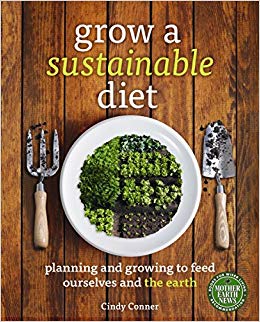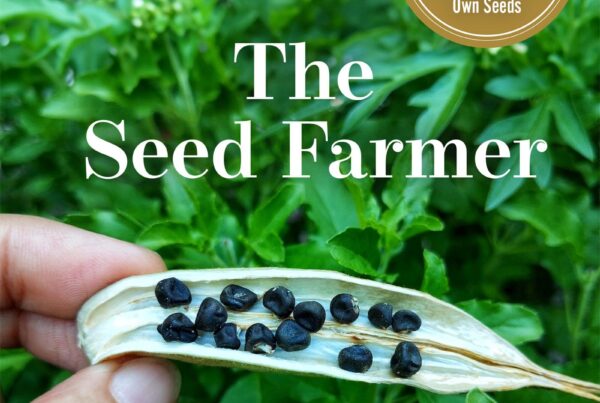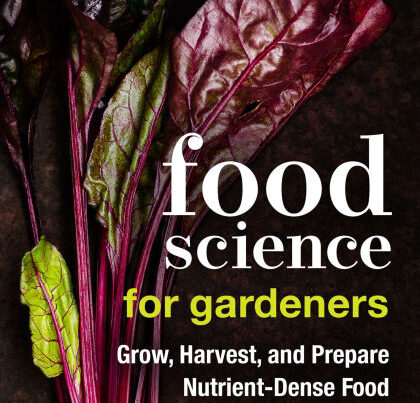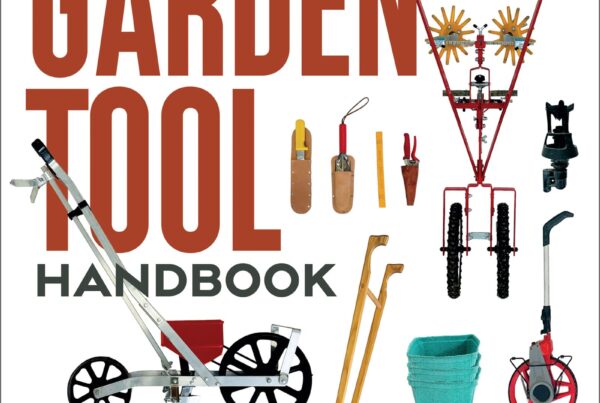
Cindy Conner, New Society Publishers 2014.
 This month’s book review brings another good book by a VABF member. Grow a Sustainable Diet is written for the backyarder or homesteader who takes food self-sufficiency and ecology seriously. Cindy Conner explains: “This book will help you learn how to calculate how much food you need and how much space you need to grow it.†To grow food crops without depleting the soil or bringing in outside inputs, for instance, you will need to dedicate 60% of your land to growing compost crops or cover crops. This challenge is not for the faint-hearted. But here you have the leader-in-a-book, you are not going it alone.
Cindy explains what she means by a sustainable diet and includes a fascinating exercise “What if the Trucks Stopped Coming?†– Where would you go to get all your food within 100 miles from home? Within 50 miles? 25? What foods would you be eating and what would disappear from your life? Would the existing farmers be able to supply everyone’s needs locally, or would you need to provide more for yourself and your household? What would your priorities need to be? Your first thought might be that you’d need to make secret stashes of food, and get guns to keep away your hungry neighbors. Cindy says she doesn’t believe guns will keep hungry people away and the better answer is to act from compassion, and work with your neighbors to meet whatever the future brings. None of us can survive without community, so let’s make sure our community is strong enough to meet the challenges.
In the Garden Maps chapter, Cindy explains how to divide the available garden space up into smaller plots or sets of beds, increasing your ease of access without losing a high percentage of potential growing space to paths. Beds curved along the contours will reduce rainwater runoff and erosion. On the other hand, straight lines are easier to hoe quickly. Design your garden to suit the ways you use the space – how you get to the chicken pen, or the compost pile. Permaculture design principles have influenced Cindy’s choices.
Next you can choose your crops. If all your nutrients are to come from your garden, you will need to pay attention to growing enough calories. Otherwise you’ll lack the energy to get to the end of the season! Cindy reports that potatoes, Jerusalem artichokes, sweet potatoes, parsnips, salsify, leeks and garlic are on the list of calories/area. Personally I can’t imagine getting a lot of calories from garlic. Besides the overwhelming flavor there is the issue of the work involved – garlic is labor intensive at certain times of year. Leeks similarly don’t seem a good source of calories per pound, even if they are good per square foot. And winter squash are easy to grow and surely full of calories. They do take space to grow, but I wouldn’t rule them out for that reason alone.
If you grow a lot of the calorie crops already mentioned, you will also be growing a lot of protein. Legumes produce more protein, at the cost of needing more space than the high calorie crops above. Beans, peanuts, peas can be interplanted with other crops to get that protein in the most space-saving way possible. Grains provide amino acids that are complementary to those in legumes, and the straw of grain crops is valuable for mulch or compost-making. Calcium is vital for bone health and there is plenty to be found in leafy cooking greens. A little oil or butter on the greens will help assimilate vitamin D, which is as important as calcium.
Oils and sweeteners are the two space-hogging challenges when it comes to food self-reliance. Sunflower and pumpkin seeds and peanuts, whether eaten whole or pressed, supply oil, as can some tree nuts. The home-grown vegan diet would be short on oils. Those who drink milk and eat eggs get some fats that way, easier by far. Some fruits store for out of season use. Honey, maple syrup and sorghum syrup can be home-produced, although you’ll be shocked the first time you see how much land and how much work goes into the vegan options. (Honey is made by small furry animals, it isn’t vegan.)
The question of How Much to Grow is important, if time, effort and land are not to be wasted. Locally-adapted varieties and your personal culinary preferences, as well as potential yields per area will influence your planning. After your first year, your record-keeping will be your guide to making improvements.
To keep your garden productive year after year, you will need to feed the soil. You can do this by bringing in organic materials as mulch or to contribute to your compost. If you worry about the reliability of the supply from outside, or whether it is contaminated with herbicides or car exhaust, or whether its production is truly sustainable, you’ll want to be as self-reliant in that department as in the rest of your enterprise. You could grow mulch crops (straw or hay) as part of a bigger farm, in rotation with grazing animals. Or you could grow all your compost and mulch crops within the boundaries of your garden.
Compost is a priceless soil amendment, adding not just organic matter and the basic nutrients but also a fine collection of microbes. There are almost as many ways of making compost as there are compost-makers. Cindy prefers the cool, slow method (using a relatively high proportion of carbon materials to nitrogen materials), in order to “farm†the particular mix of microbes that result that way. The annual pile is part of her garden rotation, built on top of one of the beds, starting in the fall. The next fall, after that compost is spread on the garden, winter rye is sown. Next spring this is cut and left as mulch. The rye has scavenged any compost left from the pile and returns the nutrients to the soil as it decomposes around the corn seed (sown into the mulch).
Earlier, I said you need to plant 60% of your garden in compost crops or mulch, to have a sustainable system. Two thirds of that space would be in carbon crops and one third in nitrogen crops. Happily, some of the compost materials will be grown as a by-product of a food crop (corn stalks are a good example). The book leads you through the process of identifying suitable crops, and best of all, provides a worksheet to help you determined Bed Crop Months. For each bed, from your plan you determine how many months that bed has food crops and how many months compost crops (remember that one crop can be both!) Winter cover crops really help achieve the goal! After considering each bed, you tally up and see if you need to find more niches for compost crops.
All the work in Cindy’s garden is done by hand, including cutting down cover crops, and this is carefully explained. The space is used very intensively, often planting several crops in the same bed to get best use of the space, and so that one can take over from another later.
Scheduling so your crops mature when you want them is the next big task, followed by planning a good crop rotation, and fitting everything into the space you’ve got. “Lay out your intentions, stay flexible and keep learning.†More worksheets are provided to help you.
Sections on looking after your seeds, on including animals, on food storage and preservation and on sheds, fences and other support systems follow. About animals: “You can plan a diet of only plants, but you would be hard pressed to fill all your nutritional needs without taking supplements, which are not part of a sustainable diet.†Hear, hear!
Cindy’s book will set you on the path to providing healthy food for your household without depleting the Earth in the process. Her conversational style will give you confidence as she breaks complex ideas into manageable steps. Beginners are talked through the process step by step. Cindy’s years of teaching college shine through. One reframing exercise I liked was this “if you have thought of weeding as drudgery, something you have to endure, begin to think of weeding as a harvest of materials for the compost pile.â€







